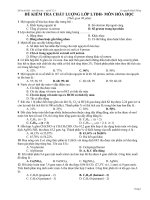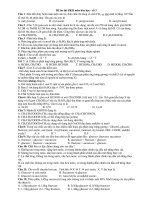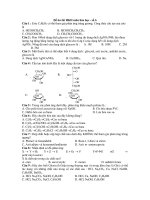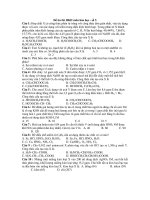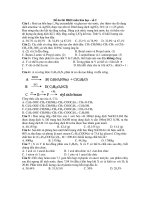Đề ôn thi thử môn hóa (707)
Bạn đang xem bản rút gọn của tài liệu. Xem và tải ngay bản đầy đủ của tài liệu tại đây (343.47 KB, 5 trang )
CHAPTER 61 Neuroimaging
753
12 seconds on a 3.0 Tesla scanner and 19 seconds on a 1.5 Tesla
scanner for the entire head. Hence, they do not typically require
patient sedation. Use of this technique offsets the radiation
burden of repeated CT scans. In the initial evaluation of hydrocephalus, MRI can be helpful in determining the level and
Hydrocephalus
Hydrocephalus can be congenital or caused by hemorrhage, tumor, and meningitis. In the neonatal period, ultrasound is used as
a screening tool in evaluating for ventricular enlargement—
in particular, associated with GMH. Beyond this period, most
monitoring of ventricular size and shunts is accomplished
with CT. Rapidly acquired heavily T2-weighted HASTE MRI
sequences have been used in the evaluation of hydrocephalus.
These sequences can be obtained as individual slices in as little as
A
1
R
L
P
• Fig. 61.23 Patient with clinical picture of transverse myelitis. Sagittal T2-
• Fig.
weighted magnetic resonance imaging of the distal cord shows central T2
hyperintensity within the conus medullaris (arrows) in this case of acute
disseminated encephalomyelitis. An acute spinal cord infarct also could
have this imaging appearance.
61.21 Acute disseminated encephalomyelitis (ADEM). Axial T2weighted magnetic resonance imaging shows symmetric increased signal
in the head of the caudate nucleus (curved arrows) and anterior lentiform
nuclei (straight arrows) associated with ADEM.
A
• Fig. 61.22 Multiple
B
sclerosis in a 16-year-old child. (A) Fluid-attenuated inversion recovery magnetic
resonance imaging (MRI) shows bilateral white matter lesions (arrows). (B) Diffusion-weighted imaging
demonstrates restriction of the left centrum semiovale lesion that was enhanced on postcontrast T1 MRI
(not shown), suggesting an acute or active lesion (arrow).
754
S E C T I O N V I Pediatric Critical Care: Neurologic
A
B
• Fig. 61.24 Epidural hematoma with skull fracture. A computed tomography scan in brain (A) and bone
(B) windows shows the typical lentiform configuration of right-sided epidural hematoma (arrows). The
bone window reveals an associated fracture (curved arrow).
Tumor
Cerebral tumors are best imaged with MRI (Fig. 61.26). Expedited evaluation of a cerebral mass can be accomplished in the
acute setting with CT, which will demonstrate the degree of mass
effect and any impending herniation or midline shift. Posterior
fossa tumors, which are more common in children and occur
more often than supratentorial tumors in the 4- to 10-year age
group,52 and suspected acute spinal cord abnormalities, possibly
associated with tumor, are best evaluated with MRI. CT is hampered by beam hardening artifact in the posterior fossa, at the
skull base, and within the spinal canal.
Seizures
• Fig. 61.25 Diffuse
brain edema with herniation. T2-weighted magnetic
resonance imaging shows diffuse cerebral swelling with effacement of
cerebrospinal fluid spaces associated with the ambient (straight arrows)
and suprasellar cisterns (curved arrows).
possible cause of CSF obstruction (see Fig. 61.17). Acute hydrocephalus can be associated with evidence of transependymal CSF
flow across the walls of the ventricular system, better appreciated
on MRI. However, the absence of this appearance does not reliably
predict the absence of increased pressure. Physiologic/functional
evaluation of shunt patency is achieved with nuclear medicine
shunt studies, as described previously.
The CT imaging yield for a single self-limited seizure with no focal neurologic deficit is low, although most children currently will
ultimately be scanned with CT or MRI. With focal neurologic
deficit or prolonged seizure activity, the imaging yield increases.
As discussed in Chapter 64, after seizures are controlled, MRI is
indicated in the absence of a clinically apparent etiology for the
seizures. Acute abnormalities on MRI, however, may be secondary to rather than reflecting the underlying cause of seizures.
Prolonged seizures can be associated with transient enhancement
due to BBB disruption and cytotoxic edema with hyperintensity
on DWI that may be confused with stroke. Positron emission
tomography can also be used to identify epileptogenic foci by
identifying areas of hypermetabolism.
Conclusion
The ultimate selection of imaging modality will depend on
clinical question(s), age and condition of the patient, and the
locally available imaging technology. Consultation with radiology colleagues is encouraged, and discussion of the clinical scenario and suspicions yields an appropriately tailored imaging
protocol and a more relevant interpretation, which is becoming
increasingly important with the ever-increasing complexity of
imaging modalities.
CHAPTER 61 Neuroimaging
A
B
755
C
• Fig. 61.26 Posterior
fossa medulloblastoma. Axial noncontrast computed tomography scan (A) and
sagittal T1-weighted magnetic resonance imaging (MRI) with gadolinium (B) show a midline posterior
fossa mass that has heterogeneous enhancement on postcontrast T1 and heterogeneous signal on axial
T2-weighted MRI (C).
Key References
Barry M, Hallam DK, Bernard TJ, Amlie-Lefond C. What is the role of mechanical thrombectomy in childhood stroke? Pediatr Neurol. 2019;95:19-25.
Blumfield E, Swenson DW, Iyer RS, Stanescu AL. Gadolinium-based
contrast agents: review of recent literature on magnetic resonance
imaging signal intensity changes and tissue deposits, with emphasis
on pediatric patients. Pediatr Radiol. 2019;49(4):448-457.
LaRovere KL, O’Brien NF. Transcranial Doppler sonography in pediatric neurocritical care: a review of clinical applications and case illustrations in the
pediatric intensive care unit. J Ultrasound Med. 2015;34(12):2121-2132.
Mascalchi M, Filippi M, Floris R, Fonda C, Gasparotti R, Villari N.
Diffusion-weighted MR of the brain: methodology and clinical application. Radiol Med. 2005;109(3):155-197.
Mendichovszky IA, Marks SD, Simcock CM, Olsen OE. Gadolinium
and nephrogenic systemic fibrosis: time to tighten practice. Pediatr
Radiol. 2008;38(5):489-496; quiz 602-603.
Ment LR, Bada HS, Barnes P, et al. Practice parameter: neuroimaging of
the neonate: report of the Quality Standards Subcommittee of the
American Academy of Neurology and the Practice Committee of the
Child Neurology Society. Neurology. 2002;58(12):1726-1738.
Nickerson JP, Richner B, Santy K, et al. Neuroimaging of pediatric intracranial infection—part 1: techniques and bacterial infections. J Neuroimaging. 2012;22(2):e42-e51.
Nickerson JP, Richner B, Santy K, et al. Neuroimaging of pediatric intracranial infection—part 2: TORCH, viral, fungal, and parasitic infections. J Neuroimaging. 2012;22(2):e52-e63.
Poussaint TY, Panigrahy A, Huisman TA. Pediatric brain tumors. Pediatr
Radiol. 2015;45(suppl 3):S443-S453.
Schaefer PW, Grant PE, Gonzalez RG. Diffusion-weighted MR imaging
of the brain. Radiology. 2000;217(2):331-345.
The full reference list for this chapter is available atExpertConsult.com.
ee1
References
1. Lowe LH, Bulas DI. Transcranial Doppler imaging in children:
sickle cell screening and beyond. Pediatr Radiol. 2005;35(1):54-65.
2. Soetaert AM, Lowe LH, Formen C. Pediatric cranial Doppler sonography in children: non-sickle cell applications. Curr Probl Diagn
Radiol. 2009;38(5):218-227.
3. Rasulo FA, De Peri E, Lavinio A. Transcranial Doppler ultrasonography in intensive care. Eur J Anaesthesiol Suppl. 2008;42:167-173.
4. Adams RJ. Big strokes in small persons. Arch Neurol. 2007;64(11):
1567-1574.
5. LaRovere KL, O’Brien NF. Transcranial Doppler sonography in pediatric neurocritical care: a review of clinical applications and case
illustrations in the pediatric intensive care unit. J Ultrasound Med.
2015;34(12):2121-2132.
6. Rilinger JF, Smith CM, deRegnier RAO, et al. Transcranial Doppler
identification of neurologic injury during pediatric extracorporeal
membrane oxygenation therapy. J Stroke Cerebrovasc Dis. 2017;26(10):
2336-2345.
7. Siegel MJ, Ramirez-Giraldo JC. Dual-Energy CT in children: imaging
algorithms and clinical applications. Radiology. 2019;291(2):286-297.
8. Kanamalla US, Ibarra RA, Jinkins JR. Imaging of cranial meningitis
and ventriculitis. Neuroimaging Clin N Am. 2000;10(2):309-331.
9. Mendichovszky IA, Marks SD, Simcock CM, Olsen OE. Gadolinium and nephrogenic systemic fibrosis: time to tighten practice. Pediatr Radiol. 2008;38(5):489-496; quiz 602-603.
10. Blumfield E, Swenson DW, Iyer RS, Stanescu AL. Gadoliniumbased contrast agents - review of recent literature on magnetic resonance imaging signal intensity changes and tissue deposits, with
emphasis on pediatric patients. Pediatr Radiol. 2019;49(4):448-457.
11. Romero JM, Schaefer PW, Grant PE, Becerra L, González RG. Diffusion MR imaging of acute ischemic stroke. Neuroimaging Clin N
Am. 2002;12(1):35-53.
12. Mascalchi M, Filippi M, Floris R, Fonda C, Gasparotti R, Villari N.
Diffusion-weighted MR of the brain: methodology and clinical application. Radiol Med. 2005;109(3):155-197.
13. Mandell DM, Mossa-Basha M, Qiao Y, et al. Intracranial vessel wall
MRI: principles and expert consensus recommendations of the
American Society of Neuroradiology. 2017;38:218-229.
14. Chen J, Licht DJ, Smith SE, et al. Arterial spin labeling perfusion
MRI in pediatric arterial ischemic stroke: initial experiences. J Magn
Reson Imaging. 2009;29(2):282-290.
15. van den Tweel XW, Nederveen AJ, Majoie CB, et al. Cerebral blood
flow measurement in children with sickle cell disease using continuous arterial spin labeling at 3.0-Tesla MRI. Stroke. 2009;40(3):
795-800.
16. Saneto RP, Friedman SD, Shaw DWW. Neuroimaging of mitochondrial disease. Mitochondrion. 2008;8(5-6):396-413.
17. Clark JF, Cecil KM. Diagnostic methods and recommendations for
the cerebral creatine deficiency syndromes. Pediatr Res. 2015;77(3):
398-405.
18. Tomandl BF, Köstner NC, Schempershofe M, et al. CT angiography
of intracranial aneurysms: a focus on postprocessing. Radiographics.
2004;24(3):637-655.
19. Sari S, Verim S, Hamcan S, et al. MRI diagnosis of dural sinus Cortical venous thrombosis: Immediate post-contrast 3D GRE
T1-weighted imaging versus unenhanced MR venography and conventional MR sequences. Clin Neurol Neurosurg. 2015;134:44-54.
20. Cloft HJ, Joseph GJ, Dion JE. Risk of cerebral angiography in patients with subarachnoid hemorrhage, cerebral aneurysm, and arteriovenous malformation: a meta-analysis. Stroke. 1999;30(2):
317-320.
21. Willinsky RA, Taylor SM, TerBrugge K, Farb RI, Tomlinson G,
Montanera W. Neurologic complications of cerebral angiography:
prospective analysis of 2,899 procedures and review of the literature.
Radiology. 2003;227(2):522-528.
22. Barry M, Hallam DK, Bernard TJ, Amlie-Lefond C. What is the role
of mechanical thrombectomy in childhood stroke? Pediatr Neurol.
2019;95:19-25.
23. Debillon T, N’Guyen S, Muet A, Quere MP, Moussaly F, Roze JC.
Limitations of ultrasonography for diagnosing white matter damage
in preterm infants. Arch Dis Child Fetal Neonatal Ed. 2003;88(4):
F275-F279.
24. Ment LR, Bada HS, Barnes P, et al. Practice parameter: neuroimaging of the neonate: report of the Quality Standards Subcommittee of
the American Academy of Neurology and the Practice Committee of
the Child Neurology Society. Neurology. 2002;58(12):1726-1738.
25. Allison JW, Seibert JJ. Transcranial Doppler in the newborn with
asphyxia. Neuroimaging Clin N Am. 1999;9(1):11-16.
26. Kashman N, Kramer U, Stavorovsky Z, et al. Prognostic significance
of hyperechogenic lesions in the basal ganglia and thalamus in neonates. J Child Neurol. 2001;16(8):591-594.
27. Ilves P, Lintrop M, Metsvaht T, Vaher U, Talvik T. Cerebral bloodflow velocities in predicting outcome of asphyxiated newborn infants. Acta Paediatr. 2004;93(4):523-528.
28. Nishimaki S, Iwasaki S, Minamisawa S, Seki K, Yokota S. Blood flow
velocities in the anterior cerebral artery and basilar artery in asphyxiated infants. J Ultrasound Med. 2008;27(6):955-960.
29. Kucinski T. Unenhanced CT and acute stroke physiology. Neuroimaging Clin N Am. 2005;15(2):397-407, xi-xii.
30. Krishnamoorthy KS, Soman TB, Takeoka M, Schaefer PW. Diffusionweighted imaging in neonatal cerebral infarction: clinical utility and
follow-up. J Child Neurol. 2000;15(9):592-602.
31. Boichot C, Walker PM, Durand C, et al. Term neonate prognoses
after perinatal asphyxia: contributions of MR imaging, MR spectroscopy, relaxation times, and apparent diffusion coefficients. Radiology.
2006;239(3):839-848.
32. Schaefer PW, Grant PE, Gonzalez RG. Diffusion-weighted MR
imaging of the brain. Radiology. 2000;217(2):331-345.
33. Qiao M, Latta P, Meng S, Tomanek B, Tuor UI. Development of
acute edema following cerebral hypoxia-ischemia in neonatal compared with juvenile rats using magnetic resonance imaging. Pediatr
Res. 2004;55(1):101-106.
34. Qiao M, Malisza KL, Del Bigio MR, Tuor UI. Correlation of cerebral hypoxic-ischemic T2 changes with tissue alterations in water
content and protein extravasation. Stroke. 2001;32(4):958-963.
35. Grandin CB, Duprez TP, Smith AM, et al. Which MR-derived perfusion parameters are the best predictors of infarct growth in hyperacute stroke? Comparative study between relative and quantitative
measurements. Radiology. 2002;223(2):361-370.
36. Barkovich AJ, Baranski K, Vigneron D, et al. Proton MR spectroscopy for the evaluation of brain injury in asphyxiated, term neonates. AJNR Am J Neuroradiol. 1999;20(8):1399-1405.
37. Provenzale JM, Jahan R, Naidich TP, Fox AJ. Assessment of the patient with hyperacute stroke: imaging and therapy. Radiology.
2003;229(2):347-359.
38. van Laar PJ, Hendrikse J, Golay X, Lu H, van Osch MJ, van der
Grond J. In vivo flow territory mapping of major brain feeding arteries. Neuroimage. 2006;29(1):136-144.
39. Wasserman BA, Stone JH, Hellmann DB, Pomper MG. Reliability
of normal findings on MR imaging for excluding the diagnosis of
vasculitis of the central nervous system. AJR Am J Roentgenol. 2001;
177(2):455-459.
40. Cloft HJ, Phillips CD, Dix JE, McNulty BC, Zagardo MT, Kallmes
DF. Correlation of angiography and MR imaging in cerebral vasculitis. Acta Radiol. 1999;40(1):83-87.
41. Jordan LC, Johnston SC, Wu YW, Sidney S, Fullerton HJ. The importance of cerebral aneurysms in childhood hemorrhagic stroke: a
population-based study. Stroke. 2009;40(2):400-405.
42. Mitchell PJ, Rosenfeld JV, Dargaville P, et al. Endovascular management of vein of Galen aneurysmal malformations presenting in the
neonatal period. AJNR Am J Neuroradiol. 2001;22(7):1403-1409.
43. Lamy C, Oppenheim C, Méder JF, Mas JL. Neuroimaging in posterior reversible encephalopathy syndrome. J Neuroimaging. 2004;14(2):
89-96.
44. Cooney MJ, Bradley WG, Symko SC, Patel ST, Groncy PK. Hypertensive encephalopathy: complication in children treated for myeloproliferative disorders—report of three cases. Radiology. 2000;214(3):711-716.
ee2
45. Nickerson JP, Richner B, Santy K, et al. Neuroimaging of pediatric
intracranial infection—part 1: techniques and bacterial infections.
J Neuroimaging. 2012;22(2):e42-e51.
46. Nickerson JP, Richner B, Santy K, et al. Neuroimaging of pediatric
intracranial infection—part 2: TORCH, viral, fungal, and parasitic
infections. J Neuroimaging. 2012;22(2):e52-e63.
47. Lo CP, Chen CY. Neuroimaging of viral infections in infants and
young children. Neuroimaging Clin N Am. 2008;18(1):119-132, viii.
48. Girard N, Confort-Gouny S, Schneider J, et al. Neuroimaging of
neonatal encephalopathies. J Neuroradiol. 2007;34(3):167-182.
49. Frigon C, Jardine DS, Weinberger E, Heckbert SR, Shaw DW. Fraction
of inspired oxygen in relation to cerebrospinal fluid hyperintensity
on FLAIR MR imaging of the brain in children and young adults
undergoing anesthesia. AJR Am J Roentgenol. 2002;179(3):791-796.
50. Luthra G, Parihar A, Nath K, et al. Comparative evaluation of fungal, tubercular, and pyogenic brain abscesses with conventional and
diffusion MR imaging and proton MR spectroscopy. AJNR Am J
Neuroradiol. 2007;28(7):1332-1338.
51. Mueller-Mang C, Castillo M, Mang TG, Cartes-Zumelzu F, Weber M,
Thurnher MM. Fungal versus bacterial brain abscesses: is diffusionweighted MR imaging a useful tool in the differential diagnosis? Neuroradiology. 2007;49(8):651-657.
52. Poussaint TY, Panigrahy A, Huisman TA. Pediatric brain tumors.
Pediatr Radiol. 2015;45(suppl 3):S443-S453.

